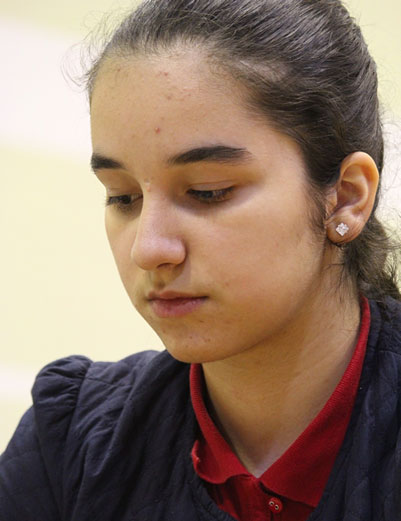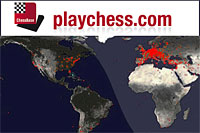
The 17th Dubai Open Chess Tournament took place from 5th – 16th April 2015 at the Dubai Chess and Culture Club, with players from at least 43 countries competing for the prestigious Sheikh Rashid Bin Hamdan Al Maktoum Cup – nine rounds Swiss, time controls: 90 min + 30 sec per move start from move one. The total prize sum was US $50,000, with the winner receiving $12,000. Cash prizes were awarded to the top 18 placers, with additional prizes for local and Arab players and for the top women scorers.
Dragan Solak wins 17th Dubai Open
By IM Sagar Shah in Dubai
Turkey’s Dragan Solak played the entire tournament very well, scripting wins over strong grandmasters like Kuzubov, Solodovnichenko and remaining unbeaten with a score of 7.0/9. He gained 19.5 Elo points and with a performance of 2753 was the deserving winner of the tournament. Maybe the only point of complaint could be his relatively uninspired 15 move draw against Eltaj Safarli in the last round.

GM Dragan Solak won the Sheikh Rashid Bin Hamdam Al Maktoum cup
by edging out his rivals on the tie-break
The tie-break that was applied in order to determine the winner was the sum of the ratings of the opponents faced. As Dragan had played against Howell, Fedoseev, Kovalenko and Kuzubov it was obvious that his average was going to be much higher than the rest. The prize money, however, was shared between the six players who finally ended at the top with 7.0/9. According to our calculations, each of the six players went home richer by US $5,367.

Eltaj Safarli, after drawing his final round game quickly against Dragan, decided to try his skills on the table football (also known as foosball) during the prayer break. He teamed up with GM Alexander Fier to make it a formidable team. However, as can be seen from the picture the Arab opponents turned out to be seasoned professionals and they crushed the GM duo!

As GM Bartel Mateusz put it, “Playing on the first board at the Dubai Open is like playing in heaven!”
The white colour and only two players on the top made it look like a World Championship Match setting
David Howell, who played the first seven rounds in heaven, was pushed back to earth in the eighth round. But he duly won it against Gadir Guseinov and set up an all-important top board clash with Vladimir Fedoseev in the last round.

Two youngsters on the top board before the start of the last round
In the game Fedoseev seemed to be in a creative mood, as he tried out the same idea which was used by Alekhine in the famous 1924 New York tournament against Emanuel Lasker. The second World Champion was able to beat Alekhine in that game with the black pieces, and a black win was also on cards in Fedoseev-Howell. But the Russian turned out to be highly resourceful as he saved the game and prevented the English player from clinching the sole first spot.

[Event "17th Dubai Chess Open"] [Site "Dubai UAE"] [Date "2015.04.14"] [Round "9.1"] [White "Fedoseev, Vladimir"] [Black "Howell, David W L"] [Result "1/2-1/2"] [ECO "D35"] [WhiteElo "2674"] [BlackElo "2686"] [Annotator "Sagar Shah"] [PlyCount "110"] [EventDate "2015.04.06"] 1. d4 Nf6 2. Nf3 d5 3. c4 e6 4. Nc3 Nbd7 5. cxd5 exd5 6. Bf4 c6 7. e3 Nh5 8. Bd3 $5 {This idea of giving up the bishop and getting doubled f-pawns is very common in the Bf4 lines, but a very important difference is that usually White has not taken cxd5. This means that the bishop on c8 is passive as there is a pawn on e6. But in the current situation without the pawn on e6. hence, the black light squared bishop will be pretty active. So all in all I think this is a pretty dubious idea.} Nxf4 9. exf4 Bd6 10. g3 O-O 11. O-O Re8 12. Qc2 Nf8 13. Rfe1 {This is the first divergence from the game Alekhine-Lasker. But I am pretty sure that both the players were not aware of this battle.} (13. Nd1 f6 14. Ne3 Be6 15. Nh4 Bc7 16. b4 Bb6 17. Nf3 Bf7 18. b5 Bh5 19. g4 Bf7 20. bxc6 Rc8 21. Qb2 bxc6 22. f5 Qd6 23. Ng2 Bc7 24. Rfe1 h5 25. h3 Nh7 26. Rxe8+ Rxe8 27. Re1 Rb8 28. Qc1 Ng5 29. Ne5 fxe5 30. Qxg5 e4 31. f6 g6 32. f4 hxg4 33. Be2 gxh3 34. Bh5 Rb2 35. Nh4 Qxf4 36. Qxf4 Bxf4 {0-1 (36) Alekhine,A-Lasker,E New York 1924}) 13... Rxe1+ 14. Rxe1 Bd7 15. f5 Qf6 16. Ne5 Re8 17. f4 {Fedoseev has played a little overambitiously, and now Howell rightly shifts his queen to the best square, hitting the d4-pawn.} Qd8 $1 {The b6 square beckons the black queen.} 18. Qb3 Qb6 19. Qxb6 axb6 {Objectively the position is equal but I would definitely prefer black. He has the bishop pair and also the queenside majority, while White's majority is not so mobile.} 20. Kf2 Ra8 21. a4 (21. Nxd7 Nxd7 22. a4 {would have been the more prudent approach.}) 21... Bc8 { Keeping the bishop pair.} 22. Bc2 Nd7 23. Kf3 Kf8 24. g4 f6 25. Nd3 {Fedoseev keeps as many pieces on the board as possible.} (25. Nxd7+ Bxd7 $15) 25... Nb8 $5 {[%csl Ga8,Gb8,Gc8] The black knight comes back to where it all began for him!} 26. b4 Na6 27. Rb1 Nc7 28. Ne2 $6 {A moment of indecision by Fedoseev. It was necessary to play actively with} (28. b5 $1 Rb8 (28... c5 29. dxc5 bxc5 30. b6 $16 {The d5 pawn falls.}) 29. a5 $132 {with very interesting play which should end in equality.}) 28... Bd7 29. Ng3 Be7 $1 {The aim is now to transfer the knight from e8-d6.} 30. h4 Ne8 31. h5 h6 $1 {White pawn's can no longer do any damage.} 32. Ne2 Nd6 33. Nb2 b5 $1 {Slowly and steadily Black has outplayed White.} 34. a5 Ne4 $1 {David Howell's accuracy is worth noting. Not only is the Nd2 fork threatened, but also the b4 pawn is hanging.} 35. Bxe4 dxe4+ 36. Kxe4 Bxb4 37. Nd3 Re8+ (37... Bxa5 38. Nc5 Bc8 39. Ra1 {It is understandable that Black wanted to avoid this pin and hence gave the check first. But here the complicating move d5 as in the game cannot be made.}) 38. Kf3 Bxa5 39. Nc5 Bc8 40. d5 $1 {Fedoseev is not one who would go down quietly. Facing the bishop pair as well as being a pawn down he has to do something drastic.} Bb6 41. Ne6+ Bxe6 42. fxe6 (42. dxe6 {[%csl Gb5,Gb7,Gc6] The three queenside passers should be enough to give Black a winning advantage.}) 42... Rd8 43. Ng3 $1 {A great move. Giving up another pawn to land the knight on f5 and create an attack on the black king with minimum forces.} Rxd5 44. Nf5 Bc5 { Stopping e7+.} 45. Ra1 Rd8 {Even though Black is two pawns up and has three queenside passers, White's activity is such that it is very difficult to improve the position. Now Fedoseev goes for even further complications.} 46. g5 $5 fxg5 47. fxg5 hxg5 48. h6 gxh6 {White is four pawns down but the game is not over.} 49. Rh1 Rd5 $1 50. Kg4 {It is imperative to maintain the knight on f5.} Re5 $2 {The final error which immediately forces Howell to split the point. The way to an advantage was not easy, especially when you have less time. But it did exist.} (50... Ke8 $1 51. Rxh6 Kd8 $1 {The king runs away from the scene of action and the bishop is all ready to sacrifice itself for the pawn.} 52. Rh8+ Kc7 53. e7 Bxe7 54. Nxe7 Rd1 $17 {How should we assess this position? The g5-pawn is going to be lost so it will be a battle between three queenside pawns vs the knight. Of course having the rooks on the board is to Black's advantage. I have a feeling that White is almost lost here. His defensive task is very difficult especially with very less time on the clock.}) 51. Rxh6 {Now the rook+knight+pawn combine to create a mating net.} Kg8 52. Rg6+ Kh7 53. Rh6+ Kg8 54. Rg6+ Kh7 55. Rh6+ Kg8 {A huge miss for the English player who could have claimed the title alone. But we must credit Fedoseev for his staunch and resourceful defence.} 1/2-1/2

At the end of the mercurial battle: a slightly depressed David Howell, who finished second,
and a highly relieved Vladimir Fedoseev who finished third

Andrei Istratescu scored a last round victory over Ipatov to finish fourth
The game Istratescu-Ipatov was filled with some great action. Ipatov played fearlessly and after Istratescu’s blunder obtained a completely winning position. But he missed his chance and in fact sacrificed further material, which was going too far. In a position where Istratescu had three minor pieces against Ipatov’s rook and five pawns, the French player showed precise technique and brought home the full point.

[Event "17th Dubai Chess Open"] [Site "Dubai UAE"] [Date "2015.04.14"] [Round "9.4"] [White "Istratescu, Andrei"] [Black "Ipatov, Alexander"] [Result "1-0"] [ECO "D80"] [WhiteElo "2630"] [BlackElo "2592"] [Annotator "Sagar Shah"] [SetUp "1"] [FEN "5rk1/1p2pp1p/1pb3p1/p1q5/P1NrP2B/8/4BPPP/1QR3K1 w - - 0 22"] [PlyCount "105"] [EventDate "2015.04.06"] {Black had given up two pieces for a rook and two pawns. Here, the position is quite balanced but the French GM goes horribly wrong with his next move.} 22. Ne3 $2 (22. Bf1 Bxe4 (22... Rxe4 23. Bg3 $13) 23. Qa1 $11 {maintains the balance.}) 22... Rb4 $1 {Ipatov seizes his moment and makes the best move. The queen cannot be taken. At the same time the White queen must defend the rook.} 23. Qa1 (23. Qc2 Qxc2 24. Rxc2 Rxe4 {and the a4 pawn falls next, and White would have lost a lot of material.} 25. Bg3 Rxa4 $19) 23... Rxa4 {Black wins another pawn with a tempo.} 24. Qb2 Qd4 $2 (24... Ra2 $1 {Would have finished off the game.} 25. Qxa2 (25. Qb1 Bxe4 $1) 25... Qxc1+ 26. Bf1 Re8 $19 {The difference between this position and the one that occurred in the game is that instead of the rooks, its the queens that are left on the board. With the black queen in action, The white pieces are all tied down, and that makes the queenside pawns to move faster down the board.}) 25. Qxd4 Rxd4 26. f3 {Black is fine but he no longer winning. Now he goes completely wrong.} Bxe4 $2 (26... f5 $1 $15) 27. fxe4 Rxe4 28. Bf2 $16 {Black has five pawns and a rook for three minor pieces, quite an unusual material balance. White is better because the pawns aren't advanced and they can be blocked quite easily. Istratescu converted this position into a win with good play.} Rd8 29. Bf3 Rb4 30. Nd5 Rb5 31. Nxb6 Rd2 32. Be3 Rd6 33. Nc4 Rd8 34. Ra1 Rc8 35. Be2 Rb4 36. Nb6 Rc2 37. Bf3 Rcb2 38. Rxa5 Rxb6 39. Bxb6 Rxb6 40. Ra7 e6 41. Rxb7 Ra6 42. Kf2 h5 43. Ke3 Ra4 44. Bc6 Ra5 45. Kd4 Kg7 46. Rb5 Ra6 47. Kc5 Ra2 48. Rb7 Rd2 49. Rd7 Rc2+ 50. Kd6 Kf6 51. Kc7 e5 52. Kd6 Rd2+ 53. Bd5 e4 54. h4 Kf5 55. Rxf7+ Kg4 56. Rg7 e3 57. Rxg6+ Kxh4 58. Re6 e2 59. Re3 Kg4 60. Ke5 h4 61. Be6+ Kg5 62. Bh3 Ra2 63. Ke4 Ra4+ 64. Kf3 e1=Q 65. Rxe1 Rf4+ 66. Ke3 Rf8 67. Rc1 Re8+ 68. Kf2 Rf8+ 69. Kg1 Rf4 70. Rc5+ Kg6 71. Kh2 Rd4 72. Bc8 Rd1 73. Bb7 Ra1 74. Bf3 1-0

Alexander Ipatov: one missed opportunity is all that separates
you from the joint first and twentieth spot!

The winner of recently held Karpos Open, Ivan Ivanisevic, finished fifth
Serbian GM Ivan Ivanisevic has quite a unique style of playing. He likes to grab material even at the cost of handing over the initiative to his opponent. With accurate defence he then swings the game in his favour. His final round game against Alexander Shabalov had similar course of events but was marred by mistakes on both sides.

[Event "17th Dubai Chess Open"] [Site "Dubai UAE"] [Date "2015.04.14"] [Round "9.3"] [White "Ivanisevic, Ivan"] [Black "Shabalov, Alexander"] [Result "1-0"] [ECO "E60"] [WhiteElo "2638"] [BlackElo "2511"] [Annotator "Sagar Shah"] [SetUp "1"] [FEN "R3R3/5pk1/6pp/8/p4P2/Pb3BP1/r2rPK1P/8 b - - 0 38"] [PlyCount "32"] [EventDate "2015.04.06"] {White had an extra pawn in the game but Black had enough activity to compensate for it. This is the critical position. White's threat is simple at the same time very dangerous. He intends to play g4 followed by g5 and weave a mating net. Black must implement prophylactic measures against this plan.} 38... Kf6 $2 (38... Rxa3 {is also met with this strong mating idea} 39. g4 $1 { g5 is a threat but here Black can minimize the damage with} Bd5 40. Bxd5 Rxd5 41. h4 Rd7 (41... g5 42. Rg8+ Kf6 43. fxg5+ hxg5 44. hxg5+ Ke5 45. Rgf8 Rd7 46. Ra5+ Ke6 47. Rf5 $16) 42. g5 hxg5 43. fxg5 f5 $16 {White is better but Black has decent chances for a draw.}) (38... h5 $1 {was the best h3-g4 is slow.} 39. h3 Rd3 $3 {The threat is Rxf3 followed by Bd5+} 40. Be4 Rdd2 41. Bf3 Rd3 42. Rab8 Rd7 43. g4 hxg4 44. hxg4 f6 $14 {Things are under control over here for Black.}) 39. g4 $1 {The game is all over. It doesn't seem so at first sight but this is true. h4 followed by g5 is going to be curtains.} g5 (39... Rxa3 40. h4 $18) 40. Ra6+ Kg7 41. f5 (41. fxg5 $1 hxg5 42. Re5 f6 43. Re7+ $18) 41... Rd4 42. f6+ Kh7 43. Be4+ Rxe4 44. Rxe4 {White is better but Black has some chances after the exchange sacrifice.} Rxa3 45. Re8 Ra1 $2 (45... Bc4 46. Rb6 (46. Raa8 Kg6) 46... Ra2 $132) 46. Rea8 $2 (46. e4 $1 $18 {with the idea of Raa8. And if Black played Kg6 this could be met with e5 with a forced mate. Hence, this was a very strong move.}) 46... Rh1 47. e4 Rxh2+ 48. Kg3 Re2 49. Re8 Bd1 $2 50. Rd6 (50. Raa8 {was easier.}) 50... Bc2 51. e5 h5 52. gxh5 a3 53. Rd7 Bb3 54. Rdd8 {Shabalov missed his chance to finish at the top in what would have been a totally dream event for him.} 1-0

Shabalov’s wonderful tournament didn’t have a happy ending

IM Vijayalakshmi Subbaraman scored 5.5/9 and won the prize for best female player

WGM Gunay Mammadzada won the prize of the second best female player.
She is just 15 years old and surely a player to watch out for.
To make my caption clear I would like to present the readers with the following position that was reached in my last round game against Gunay.
Sagar Shah - Gunay Mammadzada

My last move was Bg2-d5, and it is It’s Black to play. White is surely worse. He is a pawn down. Black can play solidly and slowly try to convert her advantage. But Gunay found the best way to win. Can you also do the same? The solution is given at the end of this report.
Final Rankings after nine rounds

The winner of the tournament: GM Dragan Solak
Pictorial impressions from the Dubai Open

Intense concentration: GM Eduardo Iturrizaga, finished with 6.0/9 points

GM Sergei Zhigalko from Belarus, 6.0/9, kibizing rival games

GM Mihaljo Stojanovic, 5.5/9 points

Style icon: GM Daniele Vocaturo finished 5.0/9, losing 13 rating points

A pretty horrible tournament for GM Abhijeet Gupta who scored 4.5/9 and lost 26 Elo points

Azari IM Zaur Mammadov, rated 2470, will remember this tournament for many years to come.
He scored 6.5/9 and made his final GM norm, gaining 17 Elo pointw that guarantees him his title.

Three Indians made IM norms at the event: N.R. Vignesh, Abhishek Kelkar
who has completed all the formalities to become an IM, and Aniruddha Deshpande

Turkish WGM Betul Yildiz had a good event, scoring 5.0/9 and gaining ten Elo points

….while her country mate WGM Kubra Ozturk had a forgettable one, losing 50 Elo points!

Zeinab Mamedyarova, sister of Shakriyar Mamedyarov, lost 28 rating points

Seeking divine assistance? Second seeded GM Igor Kovalenko finished 14th

Faisal Ali (1606) from UAE made the largest rating gain in the event, a whopping 122 points!

GM David Howell ponders over the question I posed: “What one quality, according to you,
is the most important to become a world class GM?” David’s answer: “The talent to persevere.”
The 17th Dubai Open comes to an end. In terms of quality of organization, players and playing conditions it is definitely one of the best tournaments in the world. However, little quirks like the namaaz prayer break of ten minutes at 6.45 p.m. during every round and the irregular schedule of a rest day followed by a double round are two things that must be seriously considered before playing in this tournament.
Solution to the Sagar Shah - Gunay Mammadzada puzzle

[Event "17th Dubai Chess Open"] [Site "Dubai UAE"] [Date "2015.04.14"] [Round "9.27"] [White "Sagar, Shah"] [Black "Mammadzada, Gunay"] [Result "0-1"] [ECO "A37"] [WhiteElo "2458"] [BlackElo "2336"] [Annotator "Sagar Shah"] [SetUp "1"] [FEN "5rk1/5p1p/R2p2p1/1npB1q2/8/1P4P1/3Q1P1P/6K1 b - - 0 24"] [PlyCount "9"] [EventDate "2015.04.06"] {[%cal Gg2d5] I was expecting Black to make the solid developing move Re8. But there is no concrete threat with that move.} 24... Nd4 $3 {Gunay gives up the d6-pawn. She has seen the very beautiful combination. It must be mentioned that the computer takes some time to see this amazing tactic. I thought for quite some time but could find nothing wrong with taking the pawn on d6 and hence I snapped it up.} (24... Re8 25. Kg2 {Black is better, but I hoped to resist.}) 25. Rxd6 {The bishop on d5 was hanging and hence taking this pawn is imperative.} Qe5 {This was something that I had seen beforehand.} 26. Rd7 {As she thought for her next move, I felt that she had blundered in this position and that I had saved myself from the worst. She made her next move which was very surprising.} Qe8 $1 {I still couldn't understand what her threat really was. I thought for a few minutes and then it suddenly dawned to me. A beautiful tactic awaited me.} 27. Rc7 {Reluctantly I made my move. I had nothing better than to move my rook away.} (27. Rd6 Qe7 {forcing the rook off the d-file is similar to the game.}) (27. Ra7 Qd8 $19 {is just like the game.}) 27... Qd8 $3 {[#]A beautiful concept, really. Look closely at the d-file. The bishop on d5 would be pinned against the queen on d2 if there was no knight on d4. Even though the knight exists, the bishop is still pinned because the knight can always move away from the d-file with a tempo thanks to Nf3+. Very often we see that when one side pins the other side, the pinner can fall victim to a discovered attack if the pinned piece moves. But here is the case where the side that is pinning is also threatening a discovered attack! Very unusual and that's what makes it a difficult tactic to see.} 28. Rxf7 {There was nothing better. The bishop could not be supported and if it moved, Nf3+ would win the White queen.} (28. Rxc5 Nf3+ $1 $19 {The queen is lost.}) 28... Qxd5 $19 {I lost the piece and soon the game.} 0-1


All pictures by Amruta Mokal, who is the wife of our reporter. Amruta (rated 2075)
created a big upset in round one by beating GM Daniele Vocaturo (2594) with the black pieces
























































